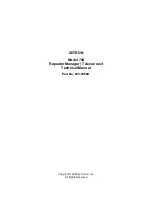
Fig. 1
3.
2.
7.
4.
8.
6.
9.
5.
1.
This heater must be used on an
A.C.~
supply only and the voltage marked
on the heater must correspond to the supply voltage. This heater is fitted
with a plug incorporating a 13 amp fuse. When replacing the fuse, a 13
amp fuse approved by ASTA to BS 1362 must be used.
If the plug is not suitable for the socket outlets in your home, the plug must
be cut off and an appropriate one fitted. A plug cut off from a mains lead
will give a shock hazard if inserted into a 13 amp socket elsewhere in the
house. To avoid this, it should be disposed of immediately.
NOTE: The fuse cover of a non-rewirable plug must be refitted when
changing the fuse. Should the cover become lost, the plug must not be
used until the correct replacement fuse cover is obtained from your supplier
or by contacting our customer helpline.
IMPORTANT:
The wires in this mains lead are coloured in accordance
with the following code:
BLUE: NEUTRAL
BROWN: LIVE
As the colours of the wires in the mains lead may not correspond with the
coloured markings in your plug, proceed as follows:
Connect the
BROWN
wire to the terminal marked ‘
L
’ or coloured
RED
.
Connect the
BLUE
wire to the terminal marked ‘
N
’ or coloured
BLACK
.
Note:
‘
L
’ or ‘
N
’ must not be connected to the
EARTH
terminal marked ‘
E
’
or ‘ ’ or coloured
GREEN
or
GREEN AND YELLOW
.
If in doubt, consult your electrician.
Main Elements -
See Fig 1.
Heat Control
- see Fig. 2
Thermostat Control -
see Fig. 3
The heat output is controlled by the thermostat, according to the room
temperature.
Turn the thermostat knob fully clockwise to
maximum setting initially. When the room is
warm enough, reduce the setting slowly until
the heater just clicks off.
The heater will now cycle on and off to maintain
your selected room temperature. An audible click
may be heard when the thermostat operates - this
is normal.
Note: If the heater does not come on when the
thermostat is at a low setting, this is normally
because the room is warmer than the thermostat
setting and is not a fault.
1. Power Indicator Light
2. Switch Knob
3. Thermostat Control Knob
4. Air Outlet
5. Tip Switch
6. Inlet Grille
7. Handle
(Q2TS, Q3TS, Q2TSO, Q3TSO)
8. Oscillating Base
(Q2TSO, Q3TSO)
9. Oscillation Switch
(Q2TSO, Q3TSO)
Fig. 3
Using the Heater
Recycling
Cleaning
Safety - overheat protection
Electrical connection
OFF
Cool Blow*
Half Heat
Full Heat
Fig. 2
Oscillation
(Q2TSO & Q3TSO Only)
Fig. 4
Model Identifier(s):
Q2TSNH
Q2TS
Q2TSO
Q3TSNH
Q3TS
Q3TSO
Heat output
Nominal heat output
Pnom
2.0
3.0
kW
Minimum heat output (indicative)
Pmin
0.8
1.5
kW
Maximum continuous heat output
Pmax,c
2.0
3.0
kW
Auxiliary electricity Consumption
At nominal heat output
elmax
0.0
0.0
kW
At minimum heat output
elmin
0.0
0.0
kW
In standby mode
elSB
0.0
0.0
kW
Type of heat output/ room temperature control
Mechanical thermostat room temperature control
Yes
Contact details
Glen Dimplex Heating & Ventilation
Millbrook House, Grange Drive, Hedge
End, Southampton.
SO30 2DF
* When the heat control is set to ‘ ’ for cool blow, set the thermostat
control to maximum.Position ‘ ’ will turn the heater on and off to maintain
a temperature of approximately 5°C.
The heater can be switched into oscillation mode by pressing the switch on
the rear of the oscillation base, see 9. - Fig1.Position ‘ ’ will turn oscillation
on and position ‘
’ will turn oscillation off, see Fig.4. The heater oscillates
back and forth on its base through 90 degrees. Oscillation feature provides
Heating and Cooling effect across a wide area. This is particularly useful
for providing maximum coverage for Heating or Cooling effect quickly
and efficiently.
For your safety, this appliance is fitted with a thermal cut-out. In the event
that the product overheats, the cut-out switches the heater off automatically.
To bring the heater back into operation, remove the cause of overheating,
then turn off the electrical supply to the heater for a few minutes.
When the heater has cooled sufficiently reconnect and switch on the heater.
If the cut-out operates repeatedly, contact your supplier.
WARNING ALWAYS DISCONNECT FROM THE POWER SUPPLY
BEFORE CLEANING THE HEATER.
Do not use detergents, abrasive cleaning powders or polish of any kind
on the heater.
Wipe with a dry cloth to remove dust and a damp cloth (not wet) to clean
off stains. Be careful not to allow moisture into the heater. This heater is
provided with an air filter. This is designed to remove large dust particles,
fluff and hair to enhance air quality. It is recommended the filter be removed
regularly to clean to avoid overheating of the element. Use a vacuum
cleaner to remove any fluff which does accumulate.
For electrical products sold within the European
Community.
At the end of the electrical products useful life it
should not be disposed of with household waste.
Please recycle where facilities exist. Check with
your Local Authority or retailer for recycling advice
in your country.






















